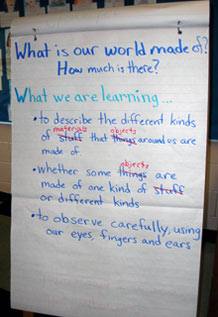What are things in my world made of?
1. Ask the question
Let the children talk freely about the question for a couple of minutes, providing only the most open-ended prompts, also in the form of questions:
- What could this question mean?
- How could we ever answer it?
- What might a scientist do to answer this question?
Note: Until you know what words the children are comfortable using, use non-technical ones and introduce the scientific terms later. In this first example, the terms “thing” and “stuff” will soon be replaced with the terms “object” and “material”.
Bring the discussion around to specific objects and materials. Look around the room and spot an object.
- What stuff (or material) is it made of?
Model how you’d like students to first name the thing and then the stuff from which it is made. Use a couple of objects from the set that students will use.
- This object I’m holding is a block, and the material it’s made of is wood.
- This is a small bear, and the stuff it’s made of is plastic.
Continue eliciting examples until you are sure students understand the difference between objects and materials.

How one teacher started
Jen allowed time for her students to write their ideas about the question before discussing it as a group.
Here is Jen’s chart with the investigation question and the goals. Note that as children discuss the goals, the word ‘stuff’ is replaced with ‘materials’ and the word ‘things’ with ‘objects’. Jen facilitated this change by asking, “Is there a more scientific word we could use?” The children came up with the more precise language on their own. If they hadn't, she would have supplied it.
Explain that some of the things students will explore may be made of stuff that’s more difficult to identify but that looking, feeling, or tapping and listening carefully, they’ll learn more about what kinds of ‘stuff’ are used in making the things that they see everyday.
Finally, pass out the set of prepared objects to each group. Let students know that their job is to think about what each object is made of, and then sort the objects into groups according to their materials. Explain that there is more than one way to sort the objects and how they go about it is up to them.
Introduce the student notebooks
Tell students that, like scientists, they will be keeping a record of their work and their results in a notebook that they will bring to every science class. Let them know that their notebook entries can include many different kinds of science information, including drawings, writing, charts, and graphs.
Encourage students to think of their notebooks as a place to record ideas and questions, too. The distinction data and ideas will not be a simple one for young students and will require regular attention and feedback as you review their notebooks.



